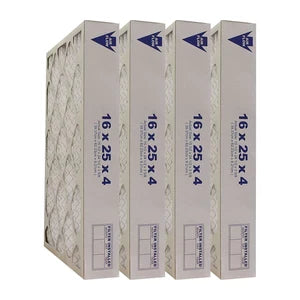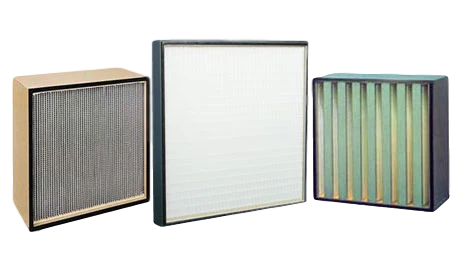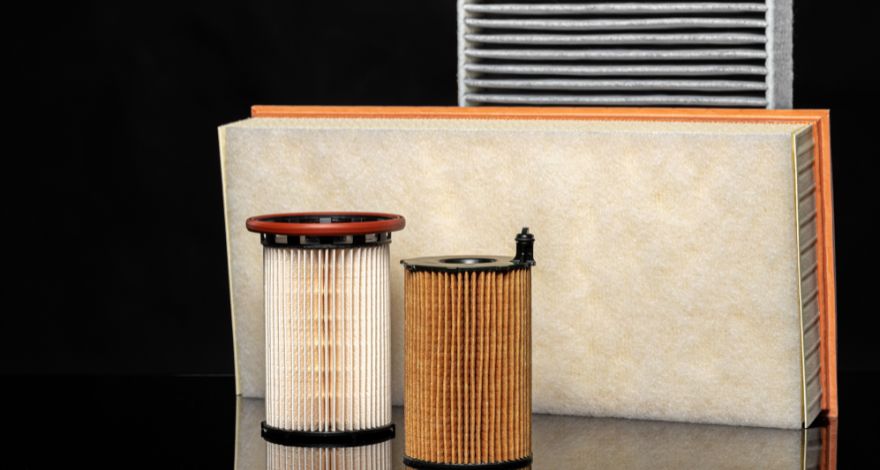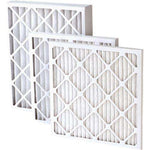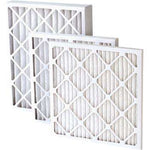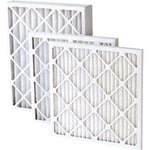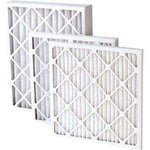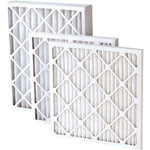Vous avez pas d'articles dans votre panier.
MERV Rating for Furnace Filters: The One Detail You Shouldn’t Ignore
Most people don’t think twice about their furnace filter until the air starts feeling dusty, their allergies flare up, or the HVAC system stops working like it should. That’s where the MERV rating for furnace filters comes in.
The number on MERV furnace filters is not just a digit. It tells you how well your filter captures the stuff you don’t want to breathe in: dust, pet dander, smoke, even bacteria.
If you're aiming for better air quality at home without putting extra strain on your system, this is what you need to focus on.
In this guide to understanding the MERV rating for furnace filters, we’ll walk you through exactly what these ratings are, how they work, and why they matter for your home.
You’ll learn the difference between MERV 8, 11, and 13, how to choose the right filter based on your needs and your HVAC system.
Plus, you’ll find out what to look out for when shopping, especially when it comes to sizing. We’ll also clear up common questions about airflow, allergens, and filter lifespan.
Buy a furnace filter that works for your home with confidence. Here’s what every homeowner must know.

What Is the MERV Rating for Furnace Filters?
The MERV rating is short for Minimum Efficiency Reporting Value, and it tells you how effective a furnace filter is at trapping airborne particles like dust, pollen, pet dander, and even bacteria.
The rating ranges from 1 to 20. The higher the number, the finer the particles it can capture. It sounds simple, but choosing the wrong MERV filter can cause real problems.
-
Mistake to avoid: One of our customers once replaced her standard filter with a MERV 13 model, thinking it would give her the cleanest air possible. It did, for about a week.
Then her system started making noise, the airflow dropped, and her energy bill jumped. Her HVAC system wasn’t built to handle the added resistance. That’s how one small number on a box ended up costing her more than it saved.
-
What the number on MERV furnace filters measures: A filter’s ability to trap particles between 0.3 and 10 microns in size.
-
What the MERV rating for furnace filters means:
-
Low MERV (1 to 4): Captures large debris like lint and carpet fibres
-
MERV 6 to 8 filter: Traps common household particles like pollen, mould spores, and dust.
-
MERV 9 to 11 filter: Handles finer particles, including pet dander and exhaust fumes. An “11” is usually the recommended MERV rating for furnace filters.
-
MERV 13 filter: Adds bacteria, smoke particles, and allergens to the list.
-
MERV 14+ filter: This is a medical-grade MERV filter. It is suitable for cleanrooms and hospitals, not most homes.
Quick tip: What is the best MERV rating for furnace filters? Some people believe the higher the number, the better it is.
However, while higher MERV means better filtration, it can also lead to more airflow resistance. If your system isn’t designed for it, it may overwork itself trying to push air through a denser filter.
The right MERV rating balances clean air with proper system performance. That’s what we’ll help you figure out next.

Why Does the MERV Rating For Furnace Filters Matter for My Home?
MERV ratings aren’t just about cleaner air. The right MERV filter directly affects how well your HVAC system performs and how comfortable your home feels day to day.
Whether you’re dealing with pets, dust, city air, or seasonal allergies, choosing the right filter can make a noticeable difference.
Here’s why the correct MERV furnace filters matter:
-
Health: MERV filtration with higher ratings can trap smaller particles like some bacteria. This helps reduce allergens and improve indoor air quality, especially important if someone in your home has asthma or sensitivities.
-
Airflow: If the filter is too dense for your system (for example, a MERV 13 in a unit designed for MERV 8), it can block airflow.
That puts extra stress on your furnace or AC, lowers efficiency, and could even shorten its lifespan.
-
Energy use: A clogged or overly restrictive filter makes your system work harder. That leads to higher energy bills and more wear and tear over time.
For most homes, the perfect MERV rating for furnace filters is between 8 and 13. This range captures what you want out of the air without straining your system.
If you’ve ever wondered why your home still feels dusty even after cleaning, or why your allergies won’t let up, your furnace filter could be the fix you didn’t know you needed.
Choosing the Best Furnace Filters: What to Look For
Picking a filter is more than selecting a MERV rating. To protect your health, your HVAC system, and your wallet, here’s what you need to know.

Consider the Filter Material
-
Synthetic (pleated) media: It’s typically polyester or polypropylene and offers better filtration of smaller particles, higher durability, and longer lifespan. These filters often start with a lower pressure drop and remain effective longer.
-
Fibreglass filters cost less and offer minimal airflow resistance. However, they require monthly replacement.
Think About Construction Quality
-
Look for rigid, well-sealed frames, preferably made of metal or sturdy cardboard. This prevents air from bypassing the filter media and ensures all incoming air gets properly filtered.
Size: Nominal vs Actual
-
The nominal size (e.g., 16×25×1) is a rounded marketing label.
-
The actual size is the filter’s true dimensions, often slightly smaller, such as 15⅝ × 24¾ × ¾.
-
A filter that doesn’t fit snugly can let unfiltered air slip past and reduce efficiency.
Fun fact: One homeowner shared that after switching to a proper-size pleated filter, their furnace ran smoother, their energy bills dropped noticeably, and allergy symptoms improved. All without upgrading their HVAC unit.
Recommended MERV Rating for Furnace Filters in Canadian Homes
If you live in Canada or the northern US, your home is sealed up for a good part of the year, especially during fall, winter, and early spring. That means less fresh outdoor air and more reliance on your furnace to keep indoor air clean.
For most Canadian homes, the perfect MERV rating for furnace filters is MERV 11 or MERV 13. These strike the right balance between filtration performance and airflow, and help manage the unique air quality challenges of colder climates.
During winter, when you’re running the heat daily and keeping windows shut, indoor pollutants tend to build up. Using the best air filters for furnace efficiency and indoor air health becomes especially important.
Quick tip: Always check your HVAC system’s specs or talk to a pro before upgrading to MERV 13. If your unit isn’t designed for high-resistance filters, you’re better off sticking with MERV 11 and changing it regularly.

Top Residential Filter Sizes to Consider
At UnitedFilter.com, we carry a wide range of furnace filter sizes to match the most common HVAC setups in Canadian and US homes. We have options for homeowners looking for a standard 1-inch filter or a deeper 5-inch model.
Here are some of our best-selling residential sizes:
-
16x20x1 – Available in MERV 8, MERV 11, and MERV 13
-
16x25x1 – A popular fit for many newer furnace models
-
20x25x4 – Ideal for homes that need extra filtration without switching to a 5-inch frame
-
16x25x5 – Comes in multiple actual sizes (like Honeywell, Carrier, and Air Bear styles) to match OEM systems
Not sure what you need? What is your recommended furnace filter?
Our team is here to help you get the right fit the first time. Invest in good furnace filters and contact us today and call (905) 403-0160 or Toll Free: (844) 834-5837.
FAQ
MERV 11 vs MERV 13, which is better?
MERV 13 filters are better at trapping smaller particles like smoke, bacteria, and allergens. However, MERV 11 still offers strong filtration and better airflow for most homes.
What is the difference between MERV 6 vs MERV 8?
MERV 8 is more effective than MERV 6 at capturing dust, pollen, and mould spores. Usually, it's a better choice for everyday indoor air quality without straining most HVAC systems.
I have allergies: what is the best MERV rating for me?
We recommend MERV 11 or MERV 13 filters for allergies, as they trap fine particles like pet dander, pollen, and dust mites effectively.
Why Should Anyone Choose Our MERV Furnace Filters?
When it comes to furnace filters, brand names aren’t everything. Many OEM filters from popular companies are priced higher simply because of the label, yet they use the same core materials as quality aftermarket options.
We focus on what really matters: performance, fit, and value.
Our MERV furnace filters are Canadian-made, built to meet the same standards as the big brands, and available in the sizes homeowners need.
They’re designed to last, support healthy airflow, and help you maintain cleaner indoor air without overpaying.
If you’ve ever been frustrated trying to match filter sizes or figure out which MERV rating is best, we’re here to help you.

Conclusion: Choosing the Right MERV Rating for Furnace Filters
The MERV rating for furnace filters plays a much bigger role in your home than most people realize. It affects everything from how clean your air feels to how well your HVAC system performs.
Also, remember that choosing the right filter isn’t about picking the highest number. It’s about finding the right balance between air quality, airflow, and system compatibility.
In summary, we’ve covered what MERV ratings mean, how different levels like MERV 8, 11, and 13 compare, why filter material and construction matter, and how important it is to match the actual size, not just the label.
To conclude, if you want healthier indoor air and a smoother-running furnace, the right MERV furnace filter makes a BIG difference. And if you're not sure which one to choose, we’re here to help you out.
Browse our full selection of high-quality, best furnace filters in Canada or reach out if you have questions. We’ll make sure you get a filter that fits, performs, and actually does what it’s supposed to.
MERV Rating for Furnace Filters: The One Detail You Shouldn’t Ignore
Most people don’t think twice about their furnace filter until the air starts feeling dusty, their allergies flare up, or the HVAC system stops working like it should. That’s where the MERV rating for furnace filters comes in.
The number on MERV furnace filters is not just a digit. It tells you how well your filter captures the stuff you don’t want to breathe in: dust, pet dander, smoke, even bacteria.
If you're aiming for better air quality at home without putting extra strain on your system, this is what you need to focus on.
In this guide to understanding the MERV rating for furnace filters, we’ll walk you through exactly what these ratings are, how they work, and why they matter for your home.
You’ll learn the difference between MERV 8, 11, and 13, how to choose the right filter based on your needs and your HVAC system.
Plus, you’ll find out what to look out for when shopping, especially when it comes to sizing. We’ll also clear up common questions about airflow, allergens, and filter lifespan.
Buy a furnace filter that works for your home with confidence. Here’s what every homeowner must know.

What Is the MERV Rating for Furnace Filters?
The MERV rating is short for Minimum Efficiency Reporting Value, and it tells you how effective a furnace filter is at trapping airborne particles like dust, pollen, pet dander, and even bacteria.
The rating ranges from 1 to 20. The higher the number, the finer the particles it can capture. It sounds simple, but choosing the wrong MERV filter can cause real problems.
-
Mistake to avoid: One of our customers once replaced her standard filter with a MERV 13 model, thinking it would give her the cleanest air possible. It did, for about a week.
Then her system started making noise, the airflow dropped, and her energy bill jumped. Her HVAC system wasn’t built to handle the added resistance. That’s how one small number on a box ended up costing her more than it saved.
-
What the number on MERV furnace filters measures: A filter’s ability to trap particles between 0.3 and 10 microns in size.
-
What the MERV rating for furnace filters means:
-
Low MERV (1 to 4): Captures large debris like lint and carpet fibres
-
MERV 6 to 8 filter: Traps common household particles like pollen, mould spores, and dust.
-
MERV 9 to 11 filter: Handles finer particles, including pet dander and exhaust fumes. An “11” is usually the recommended MERV rating for furnace filters.
-
MERV 13 filter: Adds bacteria, smoke particles, and allergens to the list.
-
MERV 14+ filter: This is a medical-grade MERV filter. It is suitable for cleanrooms and hospitals, not most homes.
Quick tip: What is the best MERV rating for furnace filters? Some people believe the higher the number, the better it is.
However, while higher MERV means better filtration, it can also lead to more airflow resistance. If your system isn’t designed for it, it may overwork itself trying to push air through a denser filter.
The right MERV rating balances clean air with proper system performance. That’s what we’ll help you figure out next.

Why Does the MERV Rating For Furnace Filters Matter for My Home?
MERV ratings aren’t just about cleaner air. The right MERV filter directly affects how well your HVAC system performs and how comfortable your home feels day to day.
Whether you’re dealing with pets, dust, city air, or seasonal allergies, choosing the right filter can make a noticeable difference.
Here’s why the correct MERV furnace filters matter:
-
Health: MERV filtration with higher ratings can trap smaller particles like some bacteria. This helps reduce allergens and improve indoor air quality, especially important if someone in your home has asthma or sensitivities.
-
Airflow: If the filter is too dense for your system (for example, a MERV 13 in a unit designed for MERV 8), it can block airflow.
That puts extra stress on your furnace or AC, lowers efficiency, and could even shorten its lifespan.
-
Energy use: A clogged or overly restrictive filter makes your system work harder. That leads to higher energy bills and more wear and tear over time.
For most homes, the perfect MERV rating for furnace filters is between 8 and 13. This range captures what you want out of the air without straining your system.
If you’ve ever wondered why your home still feels dusty even after cleaning, or why your allergies won’t let up, your furnace filter could be the fix you didn’t know you needed.
Choosing the Best Furnace Filters: What to Look For
Picking a filter is more than selecting a MERV rating. To protect your health, your HVAC system, and your wallet, here’s what you need to know.

Consider the Filter Material
-
Synthetic (pleated) media: It’s typically polyester or polypropylene and offers better filtration of smaller particles, higher durability, and longer lifespan. These filters often start with a lower pressure drop and remain effective longer.
-
Fibreglass filters cost less and offer minimal airflow resistance. However, they require monthly replacement.
Think About Construction Quality
-
Look for rigid, well-sealed frames, preferably made of metal or sturdy cardboard. This prevents air from bypassing the filter media and ensures all incoming air gets properly filtered.
Size: Nominal vs Actual
-
The nominal size (e.g., 16×25×1) is a rounded marketing label.
-
The actual size is the filter’s true dimensions, often slightly smaller, such as 15⅝ × 24¾ × ¾.
-
A filter that doesn’t fit snugly can let unfiltered air slip past and reduce efficiency.
Fun fact: One homeowner shared that after switching to a proper-size pleated filter, their furnace ran smoother, their energy bills dropped noticeably, and allergy symptoms improved. All without upgrading their HVAC unit.
Recommended MERV Rating for Furnace Filters in Canadian Homes
If you live in Canada or the northern US, your home is sealed up for a good part of the year, especially during fall, winter, and early spring. That means less fresh outdoor air and more reliance on your furnace to keep indoor air clean.
For most Canadian homes, the perfect MERV rating for furnace filters is MERV 11 or MERV 13. These strike the right balance between filtration performance and airflow, and help manage the unique air quality challenges of colder climates.
During winter, when you’re running the heat daily and keeping windows shut, indoor pollutants tend to build up. Using the best air filters for furnace efficiency and indoor air health becomes especially important.
Quick tip: Always check your HVAC system’s specs or talk to a pro before upgrading to MERV 13. If your unit isn’t designed for high-resistance filters, you’re better off sticking with MERV 11 and changing it regularly.

Top Residential Filter Sizes to Consider
At UnitedFilter.com, we carry a wide range of furnace filter sizes to match the most common HVAC setups in Canadian and US homes. We have options for homeowners looking for a standard 1-inch filter or a deeper 5-inch model.
Here are some of our best-selling residential sizes:
-
16x20x1 – Available in MERV 8, MERV 11, and MERV 13
-
16x25x1 – A popular fit for many newer furnace models
-
20x25x4 – Ideal for homes that need extra filtration without switching to a 5-inch frame
-
16x25x5 – Comes in multiple actual sizes (like Honeywell, Carrier, and Air Bear styles) to match OEM systems
Not sure what you need? What is your recommended furnace filter?
Our team is here to help you get the right fit the first time. Invest in good furnace filters and contact us today and call (905) 403-0160 or Toll Free: (844) 834-5837.
FAQ
MERV 11 vs MERV 13, which is better?
MERV 13 filters are better at trapping smaller particles like smoke, bacteria, and allergens. However, MERV 11 still offers strong filtration and better airflow for most homes.
What is the difference between MERV 6 vs MERV 8?
MERV 8 is more effective than MERV 6 at capturing dust, pollen, and mould spores. Usually, it's a better choice for everyday indoor air quality without straining most HVAC systems.
I have allergies: what is the best MERV rating for me?
We recommend MERV 11 or MERV 13 filters for allergies, as they trap fine particles like pet dander, pollen, and dust mites effectively.
Why Should Anyone Choose Our MERV Furnace Filters?
When it comes to furnace filters, brand names aren’t everything. Many OEM filters from popular companies are priced higher simply because of the label, yet they use the same core materials as quality aftermarket options.
We focus on what really matters: performance, fit, and value.
Our MERV furnace filters are Canadian-made, built to meet the same standards as the big brands, and available in the sizes homeowners need.
They’re designed to last, support healthy airflow, and help you maintain cleaner indoor air without overpaying.
If you’ve ever been frustrated trying to match filter sizes or figure out which MERV rating is best, we’re here to help you.

Conclusion: Choosing the Right MERV Rating for Furnace Filters
The MERV rating for furnace filters plays a much bigger role in your home than most people realize. It affects everything from how clean your air feels to how well your HVAC system performs.
Also, remember that choosing the right filter isn’t about picking the highest number. It’s about finding the right balance between air quality, airflow, and system compatibility.
In summary, we’ve covered what MERV ratings mean, how different levels like MERV 8, 11, and 13 compare, why filter material and construction matter, and how important it is to match the actual size, not just the label.
To conclude, if you want healthier indoor air and a smoother-running furnace, the right MERV furnace filter makes a BIG difference. And if you're not sure which one to choose, we’re here to help you out.
Browse our full selection of high-quality, best furnace filters in Canada or reach out if you have questions. We’ll make sure you get a filter that fits, performs, and actually does what it’s supposed to.
